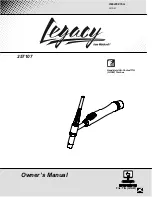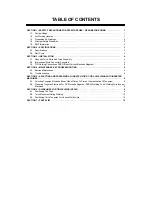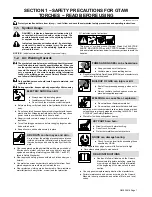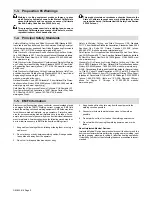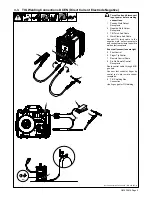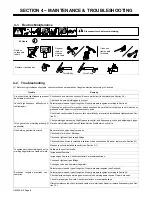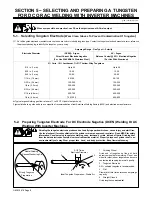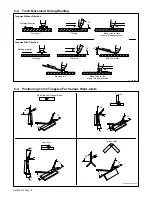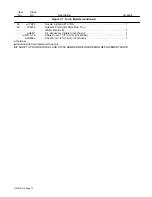
OM-235 816 Page 1
SECTION 1 −SAFETY PRECAUTIONS FOR GTAW
TORCHES − READ BEFORE USING
WC000038 − 2011-10
Protect yourself and others from injury —
read, follow, and save these important safety precautions and operating instructions.
1-1.
Symbol Usage
DANGER! − Indicates a hazardous situation which, if
not avoided, will result in death or serious injury. The
possible hazards are shown in the adjoining symbols
or explained in the text.
Indicates a hazardous situation which, if not avoided,
could result in death or serious injury. The possible
hazards are shown in the adjoining symbols or ex-
plained in the text.
NOTICE − Indicates statements not related to personal injury.
.
Indicates special instructions.
This group of symbols means Warning! Watch Out! ELECTRIC
SHOCK, MOVING PARTS, and HOT PARTS hazards. Consult sym-
bols and related instructions below for necessary actions to avoid the
hazards.
1-2.
Arc Welding Hazards
The symbols shown below are used throughout this manual
to call attention to and identify possible hazards. When you
see the symbol, watch out, and follow the related instructions
to avoid the hazard. The safety information given below is
only a summary of the more complete safety information
found in the welding power source Owner’s Manual. Read
and follow all Safety Standards.
Only qualified persons should install, operate, maintain, and
repair this unit.
During operation, keep everybody, especially children, away.
D
Always wear dry insulating gloves.
D
Insulate yourself from work and ground.
D
Do not touch live electrode or electrical parts.
D
Before welding, verify torch head is firmly attached to the torch
body.
D
Do not wrap torch hoses and power cable together with tape or
plastic wire ties. Wrapping restricts water flow which may cause
power cable to overheat and torch hose to burst.
D
Repair or replace worn, damaged, or cracked torch or cable
insulation.
D
Turn off welding power source before changing tungsten elec-
trode or torch parts.
D
Keep all covers and handle securely in place.
ELECTRIC SHOCK can kill.
Arc rays from the welding process produce intense
visible and invisible (ultraviolet and infrared) rays
that can burn eyes and skin. Sparks fly off from the
weld.
D
Wear an approved welding helmet fitted with a proper shade of
filter lenses to protect your face and eyes from arc rays and
sparks when welding or watching (see ANSI Z49.1 and Z87.1
listed in Safety Standards).
D
Wear approved safety glasses with side shields under your
helmet.
D
Use protective screens or barriers to protect others from flash,
glare and sparks; warn others not to watch the arc.
D
Wear protective clothing made from durable, flame-resistant
material (leather, heavy cotton, or wool) and foot protection.
ARC RAYS can burn eyes and skin.
D
Keep your head out of the fumes.
D
Ventilate area, or use breathing device.
D
Read Material Safety Data Sheets (MSDSs) and manufacturer’s
instructions for material used.
FUMES AND GASES can be hazardous.
BUILDUP OF GAS can injure or kill.
D
Shut off compressed gas supply when not in
use.
D
Always ventilate confined spaces or use ap-
proved air-supplied respirator.
D
Do not weld near flammable material.
D
Do not weld on containers that have held com-
bustibles, or on closed containers such as tanks, drums, or pipes
unless they are properly prepared according to AWS F4.1 and
AWS A6.0 (see Safety Standards).
D
Watch for fire; keep extinguisher nearby.
WELDING can cause fire or explosion.
HOT PARTS can burn.
D
Allow torch to cool before touching.
D
Do not touch hot metal.
D
Protect hot metal from contact by others.
NOISE can damage hearing.
D
Check for noise level limits exceeding those
specified by OSHA.
D
Use approved ear plugs or ear muffs if noise level is high.
D
Warn others nearby about noise hazard.
READ INSTRUCTIONS.
D
Read and follow all labels and the Owner’s
Manual carefully before installing, operating,
or servicing unit. Read the safety information
at the beginning of the manual and in each
section.
D
Use only genuine replacement parts from the manufacturer.
D
Perform maintenance and service according to the Owner’s
Manuals, industry standards, and national, state, and local
codes.

